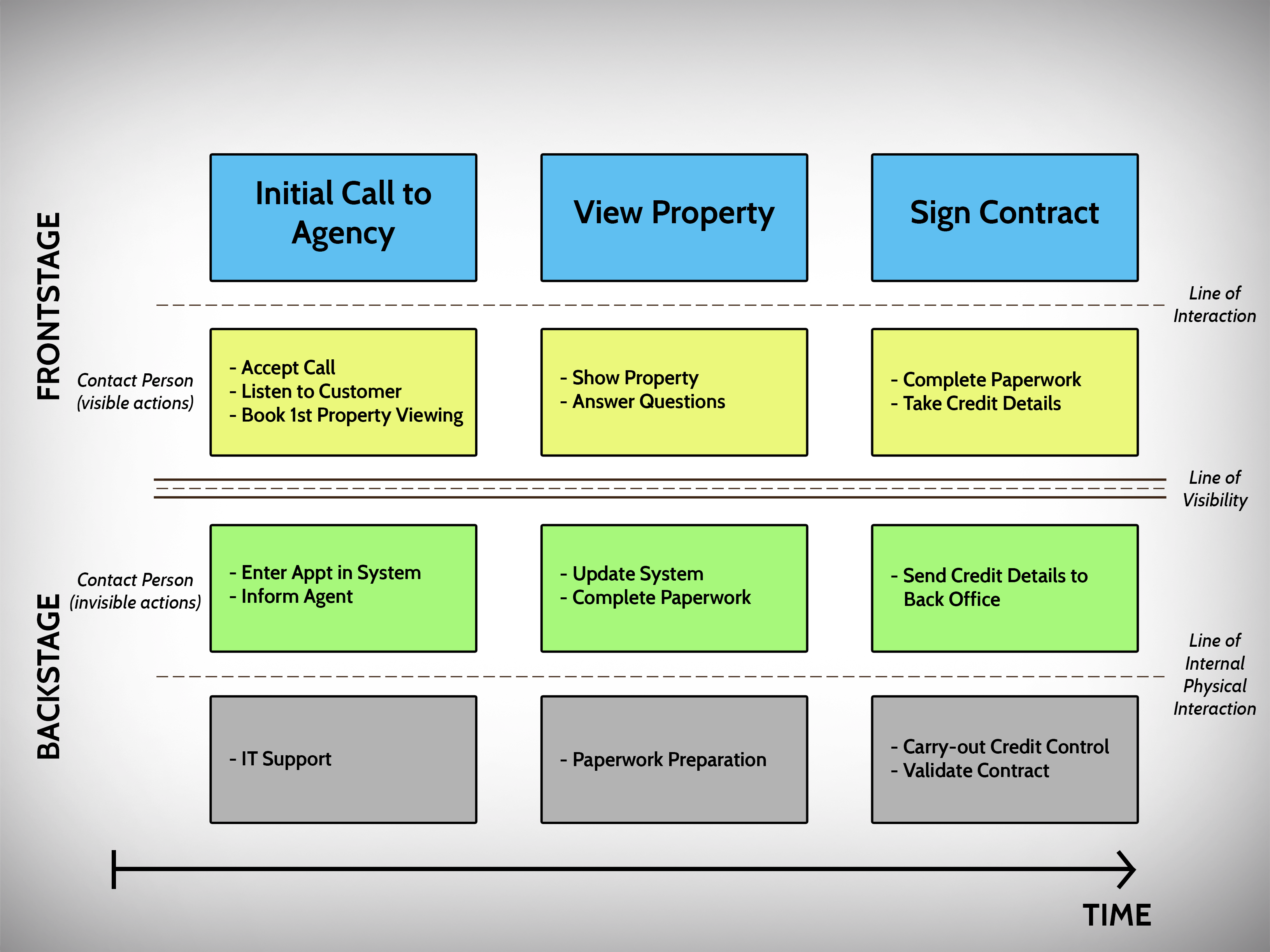Designing a Strategic Service Blueprint
Ioannis (Giannis) Kostopoulos, PhD (UK)

Delivering high-quality services first requires an effective service design process. Intentional service design ensures service reliability an important parameter of perceived service quality. Towards this direction, many service organizations all around the globe have adopted Service Blueprinting (SB) techniques as a tool for designing new services or managing existing service operations (Shostack 1984, 1987; Kingman-Brundage 1989; Fliess and Kleinaltenkamp 2004; Bitner, Ostrom, and Morgan 2008). The benefits of using a service blueprint have been detected in many organizational procedures, such as new service development, internal marketing, management and control of existing service processes, customer preferences monitoring, and service reengineering, among others.
Incorporating Service Blueprinting into the real estate context has great opportunity for growing and established agencies looking to achieve consistency and reliability across their service offerings. And as competition in the real estate industry continues to increase, a strategic and clearly-defined service blueprint can serve as an important differentiator for an agency in a saturated marketplace.
What is a Service Blueprint?
In a service blueprint, all sequences and steps of a service delivery process are identified and graphically represented in a two-dimensional flowchart. The horizontal axis represents the chronological sequence of all the sub-processes, whereas the vertical axis describes the level, within the service provider, that a task is being executed. The complexity of an SB process varies according to the complexity and divergence of the process to be mapped (Shostack 1987) and there are several approaches on how to deal with it. However, in general, the design process involves four steps: the identification of all necessary processes, the isolation of fail points, the establishment of time frames, and a cost-profit analysis (Shostack 1984).
Kingman-Brundage (1989) suggests that a blueprint should contain three detaching lines: the line of interaction, the line of visibility, and the line of internal interaction. In that way, front desk and back office activities are separated and also the customer role in the service process is taken into account. Two additional lines to consider in a service blueprint: the line of implementation, which separates support activities related to the service process and managerial activities, and the line of penetration, which separates customer induced and customer independent activities (Fliess and Kleinaltenkamp 2004).

A key aspect of the SB method incorporates the customer's view of the service delivery process within the blueprint (Zeithlnam and Bitner 2000; Bitner et. al. 2008). A customer-focused SB design process (e.g., the use of customer questionnaires, collecting information from CRM databases, etc. to design the blueprint) pushed service blueprinting to evolve from a tool for adding efficiency to a service process to a map that includes all activities that lead to creating or co-creating value for the customer. For that reason, SB should be considered a strategic process rather than simply an operational process.
Real estate agencies that engage in Service Blueprinting as a strategic process will see important benefits throughout their business, and will offer a consistent, customer-oriented, united front for their customers.
Designing a Strategic Service Blueprint for Real Estate Professionals
The strategic aspects of the service blueprinting process are of equal importance to the blueprint itself. Consider these strategic actions to help you design a successful service blueprint for your agency:
- Implement a Market-Oriented Philosophy
In order to effectively map the stages of a service delivery process, a service provider must collect a great amount of information regarding the customers (Randall 1993; Fließ and Kleinaltenkamp 2004). Then, this information should be analyzed and disseminated to all functions within the company, including frontline employees, HR/training, budgeting, etc. (Baum 1990). An agency that seeks to effectively blueprint its services must embrace a market-oriented philosophy to enable knowledge-creation and dissemination.
How well do you understand your market? What ways do you collect information about your current and prospective customers? How can you improve your market orientation to create knowledge and opportunities for your agency?
- Establish a Service-Driven Environment
Companies that seek to effectively design a service blueprint that will ultimately increase customer satisfaction should first establish a service-driven environment. To do so, senior managers must ensure that everyone within the company (e.g., frontline employees, back-office personnel, supervisors, etc.) realizes the importance of customer satisfaction and that they give their best at each customer touch point to achieve satisfaction. Also, senior leadership must prioritize service quality and customer satisfaction, putting other initiatives (e.g., cost reduction) as lower priorities.
What ways does your agency promote customer satisfaction across all touch points? How can you communicate your commitment to a service-driven environment more effectively to your internal team? To your customers
- Give Emphasis to the Details
It is often said "the Devil is in the details." In a service blueprinting process, the same is true, as the key factor of success lies in the details of your service processes. Service organizations increase the service blueprint's detail to align the company's operational policies with the goal of satisfying the needs of the customer. Although customers may do business with the company repeatedly, customer needs change over time. Also, customers' expectations change as they become aware of competitive offerings. By increasing the detail of the service design process, the company ensures a more systematic approach in balancing both operational efficiency and effectiveness (Froehle et al. 2000).
Create a detailed description of the tasks involved in your service delivery process. Some of these tasks may include times of execution, quality standards, employees involved, costs, and the corresponding potential deviations, among others.
What details might you be overlooking in your service process that could help increase your agency's customer satisfaction? How can you better align your agency's operational policies with your customer satisfaction goals?
- Follow Formal Procedures
In a service blueprinting process, the reliability and accuracy that formal planning procedures offer is necessary, especially in order to ensure standardization across the company. As noted by Baum (1990), most of the times a blueprint design fails to succeed, it is because the blueprint is designed hastily and crucial elements of the company's actual services are not taken into account. A more formal design process will lead to the identification of a greater number of potential customer needs and difficult situations that might occur during the service delivery. Including additional alternative scenarios to serve your customers can be included in the blueprint, empowering the employees with more clear instructions on how to most effectively deliver the service.
Does your agency have a formal process for designing your service experience? Are there specific times throughout the year you meet to assess the effectiveness of your service delivery? What areas of your service delivery can you identify that may need attention to meet the changing needs of your customers?
- Involve People from Different Departments
A successful blueprinting process requires a great variety of information about customer> preferences, delivery expectations, costs associated with service delivery, employees' performance, etc. In order to gather all of this data, input from several departments within the company is necessary, and hence, people from each department should be involved in the design process. Involving the right people can be achieved either by formulating a formal team that includes people from different departments or by holding several inter-departmental meetings throughout the blueprinting process.
Who in your agency might you include to better inform your design process?
- Empower Frontline Employees
In most service companies, frontline employees have to follow formal rules and offer flexible solutions at the same time. This bifurcation can lead the frontline to misunderstand their role, especially when the information provided by their supervisors is inadequate. Given that frontline employees actually implement the procedures described in a service blueprint, it is essential that they have the freedom not only to choose the appropriate "service scenario" from the blueprint, but also adjust it based on the customer's needs. In general, the existence of a blueprint encourages such freedom by clarifying who is responsible for each decision, and hence, empowering employees who have direct contact with customers to effectively enact their roles. In addition to frontline employees, all responsible team leaders and supervisors should empower their subordinates so that they can implement the predefined procedures.
Who are the frontline employees in your agency? How can your service process be adjusted to ensure customer-facing employees are empowered to effectively enact their role?
Conclusion
The use of service blueprints can really improve the quality of the services a company provides to its customers. However, the outcome of a service blueprinting process can be positive, only if the responsible managerial team does not neglect the technique's strategic aspects.
To that end, growing and established real estate agencies looking to achieve consistency and reliability across their service offerings should invest in enabling the aforementioned strategic drivers. These strategies will ensure the success of the agency's service blueprint and will make the continuous monitoring and refinement of the blueprint much easier, leading to improved service procedures that totally satisfy customers' needs.
. . . . . . . . . . . . . . . . . . .
References
Baum, S.H. (1990), "Making Your Service Blueprint Pay Off," The Journal of Services Marketing, 4(3), Summer, 45-52.
Bitner, M., A. Ostrom, and F. Morgan (2008), "Service Blueprinting: A Practical Technique for Service Innovation," California Management Review, 50(3), 66-94.
Fließ S. and M. Kleinaltenkamp (2004), "Blueprinting the Service Company - Managing Service Processes Efficiently," Journal of Business Research, 57(4), 392-404.
Froehle, C. M., A. V. Roth, R. B. Chase, and C. A. Voss (2000), "Antecedents of New Service Development Effectiveness: An Exploratory Examination of Strategic Operations Choices," Journal of Service Research, 3(1), 3-17.
Kingman-Brundage, J. (1989), "The ABC's of Service System Blueprinting: Designing a Winning Service Strategy, Proceedings of the 7th Annual Services Marketing Conference, Chicago, IL.
Randall L. (1993), "Perceptual Blueprinting," Managing Service Quality, 3(4), 7-12.
Shostack, G.L. (1984), "Designing Services that Deliver," Harvard Business Review, 62(1), 133-139.
Shostack, G.L. (1987), "Service Positioning Through Structural Change," Journal of Marketing, 51(1), 34-43.
Zeithaml, V. and J. Bitner (2000), Services Marketing - Integrating Customer Focus across the Firm, 2nd edition, The McGraw Companies, Inc., New York, NY.
. . . . . . . . . . . . . . . . . . .
About the Author
Ioannis (Giannis) Kostopoulos, PhD
Senior Lecturer of Marketing and PR, Leeds Metropolitan University, UK
Dr. Ioannis (Giannis) Kostopoulos is a Senior Lecturer of Marketing and PR at Leeds Metropolitan University, UK. He holds a PhD in Services Marketing from Athens University of Economics and Business. He also holds a degree in Statistics and a Master of Science in Marketing and Communications with New Technologies, both from the same University. He has published many articles in peer-reviewed journals and international academic conferences. He has participated in many consulting and market research projects in the UK and Greece.